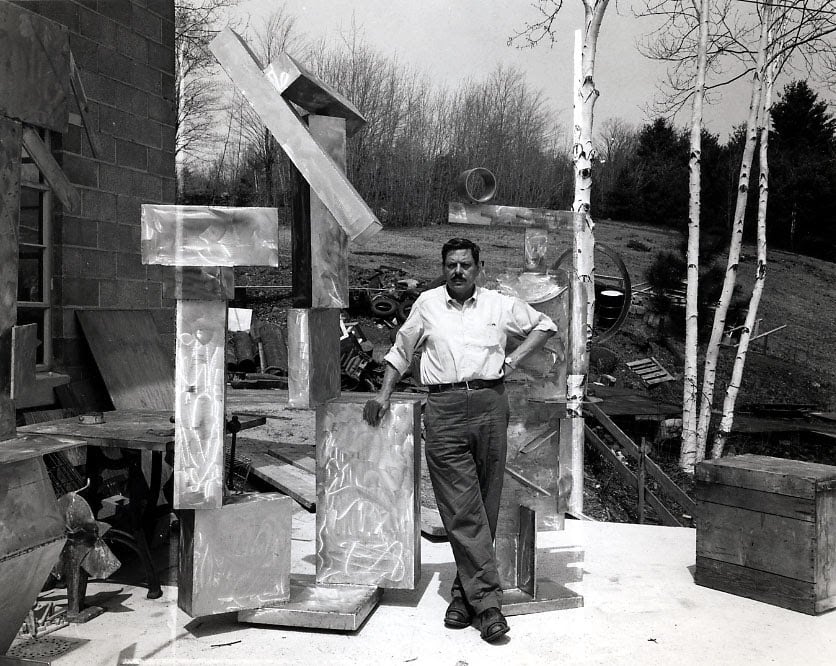
"I do not often follow its path from a previously conceived drawing. If I have a strong feeling about its start, I do not need to know its end; the battle for solution is the most important. If the end of the work seems too complete and final, posing no question, I am apt to work back from the end, that in its finality it poses a question and not a solution."
- David Smith

David Smith working on ‘The Banquet’ in 1951 at Bolton Landing. Photograph: the artist © 2019 The Estate of David Smith / Licensed by VAGA at Artists Rights Society (ARS), NY
David Smith was an American Abstract Expressionist sculptor and painter, renowned for his pioneering work in large steel abstract geometric sculptures. Born in 1926, Decatur, Indiana, Smith initially delved into painting, honing his skills at the Art Students League in New York from 1926 to 1930. At this point in time, he incorporated found objects such as shells, bones, and wood into his paintings, transforming them into three-dimensional reliefs. It was also at the League, where Smith met the painter and sculptor Dorothy Dehner, whom he would marry in 1927.
Shortly afterwards, in the early 1930s, Smith made a pivotal shift towards sculpture. Although never formally trained as sculptor, his earlier experience working at an automobile factory was of benefit. He began welding metal constructions that incorporated elements of industry, foreshadowing the innovative approaches he would later employ in sculpture. His creations from this period reflect a unique fusion of materials—machine parts, scrap metal, discarded tools— and methods that challenged established norms in sculpture.
In 1940, Smith moved permanently to Bolton Landing, New York, near Lake George in the Adirondack Mountains. He established a studio he named “Terminal Iron Works” after the machine shop where he had worked on the Brooklyn waterfront. This period marked a flourishing of his creativity, as he released a torrent of energy and ideas, creating a series of works in which he continued to include discarded industrial metal and pieces from farm equipment. A significant milestone in Smith's career was the Guggenheim Fellowship he was awarded in 1950, providing him with the resources to create more expansive and ambitious pieces. This financial freedom allowed him to venture into the realm of stainless-steel sculptures. During this time, he also began producing sculptures in series, a practice that would become a hallmark of his artistic approach.

David Smith with sculptures outside his studio at Bolton Landing, NY, ca. 1961.
In the following decades, Smith's works grew in scale, pushing the boundaries of what was traditionally conceived in sculpture. Techniques like burnishing stainless steel and utilizing spray paint marked new frontiers in his artistic expression. In 1961, Smith dedicated himself to what would be his last series: “Cubi,” consisting of twenty-eight monumental sculptures made of stainless-steel geometric cubes and cylinders that he burnished to a highly reflective surface. His ability to seamlessly integrate painting and sculpture was a testament to his belief that the only distinction between the two was the introduction of a third dimension. Smith died on May 23, 1965, in an automobile accident, near Bennington, Vermont.
During the course of his forty-year career, David Smith was the subject of his numerous one-person, group exhibitions and awards. His first solo show took place at the Willard Gallery in 1938, followed by inclusions in two traveling exhibitions organized by the Museum of Modern Art and the Whitney Museum of American Art's Annual exhibition in 1941. Smith represented the United States in the 1951 São Paulo Art Biennial and at the Venice Biennale in 1954 and 1958. Other noteworthy exhibitions include a retrospective at MoMA in 1957 and a nationwide tour of fifty sculptures in 1961. In 2006, the Solomon R. Guggenheim Museum held the landmark exhibition: David Smith: A Centennial, which brought together major sculptures by the artist, as well as drawings and notebooks compiled over the course of four decades. This was followed by David Smith: The White Sculptures at Storm King Art Center, Mountainville, New York in 2017; and David Smith: Sculpture, 1932–1965 at Yorkshire Sculpture Park, Wakefield, UK.
His works are held in the collections of numerous museums and prestigious institutions that include the Whitney Museum of American Art and the Museum of Modern Art, New York; Harvard Art Museums/Fogg Museum, Cambridge, MA; the National Gallery of Art, Washington, DC; Tate Gallery, London; and the Centre Pompidou, Paris. In 1965, Lyndon B. Johnson appointed him to the National Council on the Arts. In 2001, The David Smith Estate released the artist’s catalogue raisonné of his works spanning 1932–1965, published by Yale University Press.